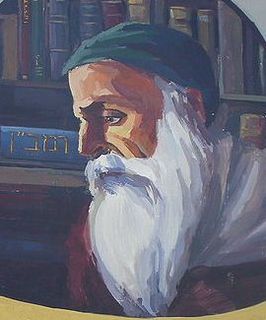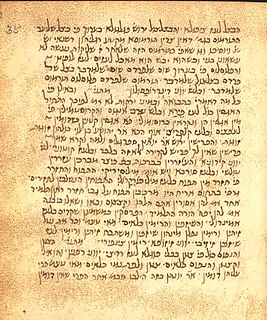Related Research Articles
Jacob ben Abba Mari ben Simson Anatoli was a translator of Arabic texts to Hebrew. He was invited to Naples by Frederick II. Under this royal patronage, and in association with Michael Scot, Anatoli made Arabic learning accessible to Western readers. Among his most important works were translations of texts by Averroes.

Moses ben Nachman, commonly known as Nachmanides, and also referred to by the acronym Ramban and by the contemporary nickname Bonastruc ça Porta, was a leading medieval Jewish scholar, Sephardic rabbi, philosopher, physician, kabbalist, and biblical commentator. He was raised, studied, and lived for most of his life in Girona, Catalonia. He is also considered to be an important figure in the re-establishment of the Jewish community in Jerusalem following its destruction by the Crusaders in 1099.

Jewish philosophy includes all philosophy carried out by Jews, or in relation to the religion of Judaism. Until modern Haskalah and Jewish emancipation, Jewish philosophy was preoccupied with attempts to reconcile coherent new ideas into the tradition of Rabbinic Judaism, thus organizing emergent ideas that are not necessarily Jewish into a uniquely Jewish scholastic framework and world-view. With their acceptance into modern society, Jews with secular educations embraced or developed entirely new philosophies to meet the demands of the world in which they now found themselves.

Sa'adiah ben Yosef Gaon (Arabic: سعيد بن يوسف الفيومي Saʻīd bin Yūsuf al-Fayyūmi; Hebrew: סעדיה בן יוסף אלפיומי גאון; alternative English Names: Rabbeinu Sa'adiah Gaon, often abbreviated RSG, Saadia b. Joseph, Saadia ben Joseph or Saadia ben Joseph of Faym or Saadia ben Joseph Al-Fayyumi; was a prominent rabbi, gaon, Jewish philosopher, and exegete who was active in the Abbasid Caliphate.
There is no specific doctrinal view of Jesus in traditional Judaism. Monotheism, a belief in the absolute unity and singularity of God, is central to Judaism, which regards the worship of a person as a form of idolatry. Therefore, consideration of Jesus as deity is not an issue in traditional Jewish thought. The rejection of Jesus as Messiah has never been a theological issue for Judaism because Jewish eschatology holds that the coming of the Messiah will be associated with events that had not occurred at the time of Jesus, such as the rebuilding of The Temple, a Messianic Age of peace, and the ingathering of Jews to their homeland.
Sefer HaIkkarim is a fifteenth-century work by rabbi Joseph Albo, a student of Hasdai Crescas. It is an eclectic, popular work, whose central task is the exposition of the principles of Judaism.

The Disputation of Tortosa was one of the famous ordered disputations between Christians and Jews of the Middle Ages, held in the years 1413–1414 in the city of Tortosa, Catalonia, Crown of Aragon. According to the Jewish Encyclopedia it was not a free and authentic debate, but was an attempt by Christians to force conversion on the Jews.
Joseph ben Shem-Tov ibn Shem-Tov was a prolific Judæo-Spanish writer born in Castile. He lived in various cities of Spain: Medina del Campo de Leon (1441); Alcalá de Henares (1451); and Segovia (1454).
Abraham ben Isaac of Narbonne (c. 1080-85 – 1158) was a Provençal rabbi, also known as Raavad II, and author of the halachic work Ha-Eshkol.
In Jewish eschatology Mashiach ben Yoseph or Messiah ben Joseph, also known as Mashiach bar/ben Ephraim, is a Jewish messiah from the tribe of Ephraim and a descendant of Joseph. The figure's origins are much debated. Some regard it as a rabbinic invention, but others defend the view that its origins are in the Torah.
Jerónimo de Santa Fe (fl. 1400–1430; born Yehosúa ben Yosef was a Spanish physician and religious writer who, after conversion to Catholicism from Judaism, wrote in Latin as Hieronymus de Sancta Fide.
Yom-Tov Lipmann ben Solomon Muhlhausen was a controversialist, Talmudist, kabalist and philosopher of the 14th and 15th centuries. His religious and scholarly career and influence spanned the Jewish communities of Bohemia, Poland, Austria and various parts of Germany, and his dispute with the principles of Christianity left a lasting imprint on the relations between Christianity and Judaism.
Joseph ben Abba Meir ben Joseph ben Jacob Caspi, was a Provençal exegete, grammarian, and philosopher, apparently influenced by Averroës.
Caleb Afendopolo was a Jewish polyhistor. He was the brother of Samuel ha-Ramati, ḥakam of the Karaite congregations in Constantinople and of Judah Bali, brother-in-law and disciple of Elijah Bashyatzi.
Shem-Tob ben Isaac Shaprut of Tudela was a Spanish Jewish philosopher, physician, and polemicist. He is often confused with the physician Shem-Tob ben Isaac of Tortosa, who lived earlier. He may also be confused with another Ibn Shaprut, Hasdai Ibn Shaprut, who corresponded with the king of the Khazars in the 900's.
Joseph ben Samuel Bonfils was a French rabbi, Talmudist, Bible commentator, and payyetan of the mid-eleventh century. He is also known by the Hebrew name Yosef Tov Elem, a Hebrew translation from the French name "Bonfils."
Nathan ben Eliezer ha-Me'ati was an Italian Jewish translator, the earliest known member of the Ha-Me'ati family that flourished at Rome in the thirteenth and fourteenth centuries. He was called the "Prince of Translators" and the "Italian Tibbonide".
Samuel Friedrich Brenz was an anti-Judaism writer, himself born Jewish. He converted to Christianity in 1601 in Feuchtwangen, and wrote Jüdischer Abgestreifter Schlangenbalg, in which he bitterly attacked his former coreligionists, whom he accused of hating "the most pious and innocent Jew, Jesus Christ," and in which he denounced their religious literature. This book, divided into seven chapters, was published in Nuremberg in 1614, 1680, and 1715.
Jewish polemics and apologetics in the Middle Ages were texts written to protect and dissuade Jewish communities from conversion to Christianity, or more rarely to Islam. The terms polemics and apologetics may be distinguished but may also be considered somewhat subjective. A smaller number of proselytizing text also exists intended to convert Christians, or more rarely Muslims, to Judaism. However, the vast majority of Jewish polemical literature was written in response to Christian polemical writings and with a permanent reference to Christian arguments.

Isaac ben Melchizedek, also known by the acronym Ribmaṣ, was a rabbinic scholar from Siponto in Italy, and one of the first medieval scholars to have composed a commentary on the Mishnah, although today only Seder Zera'im survives. Elements of the Mishnaic order of Taharot are also cited in his name by the Tosafists, but the complete work is no longer extant.
References
- ↑ Philippe Bobichon, Manuscrits en caractères hébreux conservés dans les bibliothèques de France, vol. V : Manuscrits de Théologie, Brepols, Turnhout, 2015, pp. 138-147.
![]() This article incorporates text from a publication now in the public domain : Solomon Schechter and Isaac Broydé (1901–1906). "Official, Joseph ben Nathan". In Singer, Isidore; et al. (eds.). The Jewish Encyclopedia . New York: Funk & Wagnalls.
This article incorporates text from a publication now in the public domain : Solomon Schechter and Isaac Broydé (1901–1906). "Official, Joseph ben Nathan". In Singer, Isidore; et al. (eds.). The Jewish Encyclopedia . New York: Funk & Wagnalls.